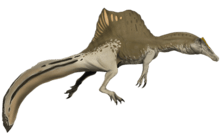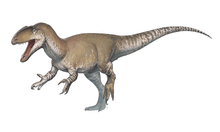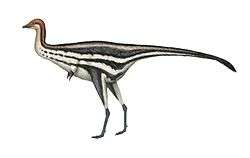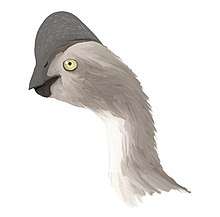Heyuannia
Heyuannia ("from Heyuan") is a genus of oviraptorid dinosaur that lived during the Late Cretaceous Period in China. It was the first oviraptorid found in that country; most others were found in neighbouring Mongolia. Two species are known: H. huangi, named by Lü Junchang in 2002; and H. yanshini, originally named as a separate genus Ingenia by Rinchen Barsbold in 1981 (and renamed to Ajancingenia in 2013 due to the preoccupation of Ingenia).
| Heyuannia | |
|---|---|
 | |
| Skeletal reconstruction of H. huangi | |
| Scientific classification | |
| Kingdom: | Animalia |
| Phylum: | Chordata |
| Clade: | Dinosauria |
| Clade: | Saurischia |
| Clade: | Theropoda |
| Family: | †Oviraptoridae |
| Subfamily: | †Heyuanninae |
| Genus: | †Heyuannia Lü, 2002 |
| Type species | |
| Heyuannia huangi Lü, 2002 | |
| Other species | |
| |
| Synonyms | |
| |
Discovery and naming
H. huangi
The type species, Heyuannia huangi, was named and described by Lü Junchang in 2002. The generic name refers to the city of Heyuan. The specific name honours Huang Dong, the director of the Heyuan Museum. The holotype, HYMV1-1, was discovered in Guangdong near Huangsha in layers of the Dalangshan Formation. It consists of a partial skeleton, including the skull. Six further skeletons were assigned as paratypes or referred to the species. Multiple other fossils have been found, including one which may retain possible reproductive organs. Thousands of eggs have also been uncovered at the site, some of them belonging to the genus and likely laid by Heyuannia.[1]
H. yanshini
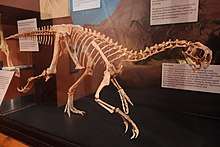
H. yanshini was first described and named by Rinchen Barsbold in 1981, as a new genus and species Ingenia yanshini. The name "Ingenia" derives from the Ingen Khoboor Depression of Bayankhongor Province, Mongolia, from whence it was collected, while the specific name yanshini was chosen in honour of academician Aleksandr Leonidovich Yanshin (1911–1999), who was adviser and mentor to Rinchen Barsbold during his time at the Paleontological Institute in St. Petersburg, Russia.[2]
The generic name Ingenia was preoccupied by the generic name of Ingenia mirabilis (Gerlach, 1957), a tripyloidid nematode. Thus, an alternative generic name, Ajancingenia, was proposed by Jesse Easter in 2013. The replacement generic name is derived also from ajanc (аянч; a traveler in Mongolian), as a Western allusion to sticking one's thumb out for hitchhiking, in reference to the first manual ungual of Ajancingenia which is twice as large as the second.[3]
Description

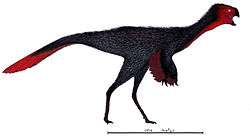
Heyuannia is a medium-sized oviraptorid. Gregory S. Paul in 2010 estimated its length at 1.5 metres, the weight at twenty kilograms.[4] Its toothless skull is relatively short with a steep snout. It had very short arms and digits, and its first digit was reduced.[5]
Classification

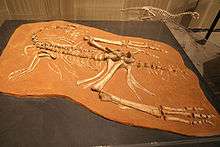
Heyuannia was assigned by Lü to the Oviraptoridae in 2002. Its exact placement within this group is uncertain. Later analyses either resulted in a position in the Oviraptorinae or the Ingeniinae. According to Lü the morphology of the shoulder girdle of Heyuannia supports the hypothesis that oviraptosaurians were secondarily flightless birds.[6]
The following cladogram follows the 2017 phylogenetic analysis by Funston and colleagues:[7]
| Oviraptoridae |
| ||||||||||||||||||||||||||||||||||||||||||||||||||||||||||||||||||||||||||||||||||||||||||||||||||||||
Paleobiology

Preservation of the pigments biliverdin and protoporphyrin in eggshells belonging to Heyuannia indicate that they were blue-green in color. This coloration allowed for both camouflage and sexual signalling, also seen in American robins and ratites. The arrangement of the eggshells suggests a partially open nest arrangement for Heyuannia, and also indicates that it engaged in increased parental care.[8]
See also
References
- Lü, J (2002). "A new oviraptorosaurid (Theropoda: Oviraptorosauria) from the Late Cretaceous of southern China". Journal of Vertebrate Paleontology. 22: 871–875. doi:10.1671/0272-4634(2002)022[0871:anotof]2.0.co;2.
- Barsbold, R. (1981). "Bezzubye khishchnye dinozavry Mongolii." [Toothless carnivorous dinosaurs of Mongolia.]. Trudy -- Sovmestnaya Sovetsko-Mongol'skaya Paleontologicheskaya Ekspeditsiya, 15: 28-39, 124. [in Russian, w/ English summary].
- Easter, J. (2013). "A new name for the oviraptorid dinosaur "Ingenia" yanshini (Barsbold, 1981; preoccupied by Gerlach, 1957)". Zootaxa. 3737 (2): 184–190. doi:10.11646/zootaxa.3737.2.6. PMID 25112747.
- Paul, G.S., 2010, The Princeton Field Guide to Dinosaurs, Princeton University Press p. 154
- Lü, J. (2005). Oviraptorid dinosaurs from Southern China. Beijing: Geological Publishing House. ISBN 7-116-04368-3. 200 pages + 8 plates. (In Chinese: pp 1-83, including 36 figures & 3 tables. In English: pp 85-200, including 5 geological figures.)
- Lü J., Huang D. and Qiu L., 2005, "The Pectoral Girdle and the Forelimb of Heyuannia (Dinosauria: Oviraptorosauria)". In: Carpenter (ed.). The Carnivorous Dinosaurs. Indiana University Press. pp 256-273
- Funston, G. F.; Mendonca, S. E.; Currie, P. J.; Barsbold, R. (2017). "Oviraptorosaur anatomy, diversity and ecology in the Nemegt Basin". Palaeogeography, Palaeoclimatology, Palaeoecology. doi:10.1016/j.palaeo.2017.10.023.
- Wiemann, J.; Yang, T.-R.; Sander, P.N.; Schneider, M.; Engeser, M.; Kath-Schorr, S.; Müller, C.E.; Sander, P.M. (2017). "Dinosaur origin of egg color: oviraptors laid blue-green eggs". PeerJ. 5: e3706. doi:10.7717/peerj.3706. PMC 5580385. PMID 28875070.



